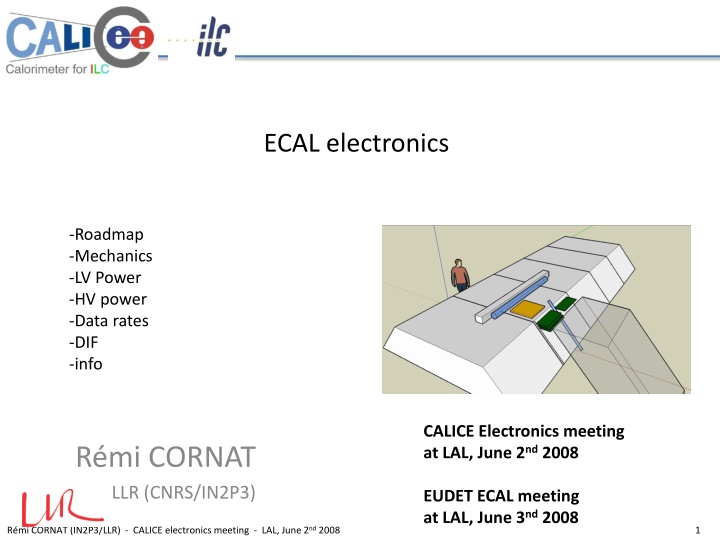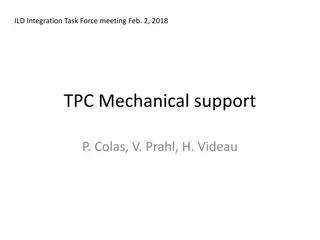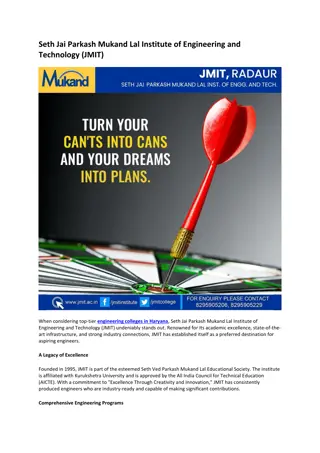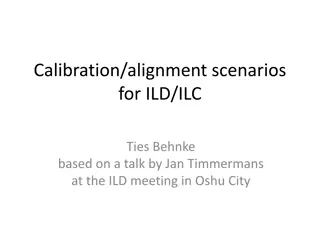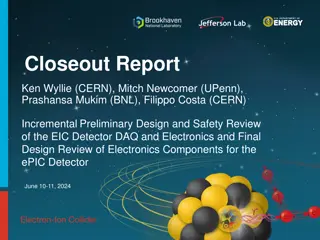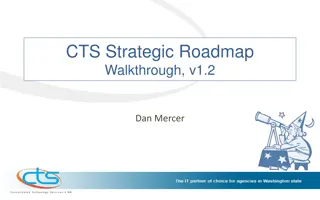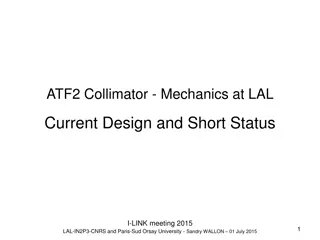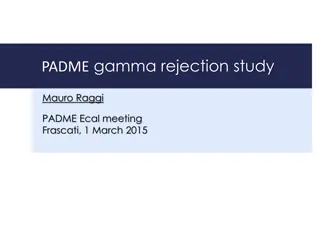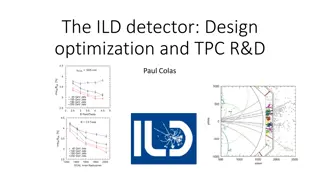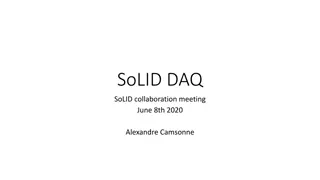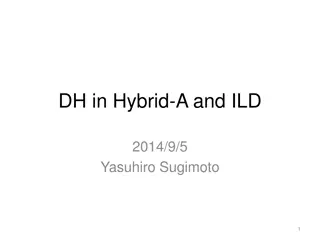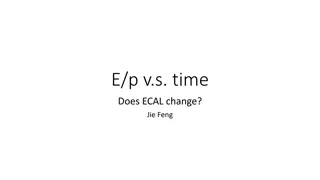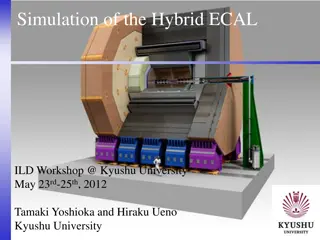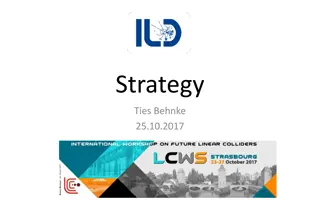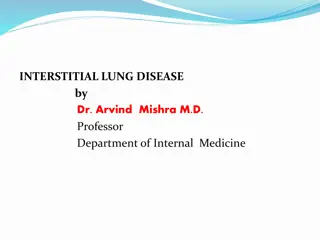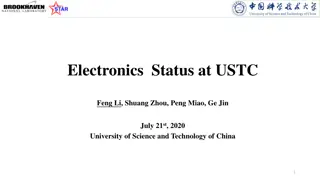Meeting on ECAL Electronics Roadmap and ILD at LAL
Status update on ECAL electronics, mechanics, LV and HV power, data rates, and DIF info discussed at the CALICE Electronics meeting at LAL in June 2008. Topics covered include roadmap demonstrations, EUDET prototypes, uncertainties around SLAB thickness, electronics progress, and ILD section conclusions.
Download Presentation

Please find below an Image/Link to download the presentation.
The content on the website is provided AS IS for your information and personal use only. It may not be sold, licensed, or shared on other websites without obtaining consent from the author.If you encounter any issues during the download, it is possible that the publisher has removed the file from their server.
You are allowed to download the files provided on this website for personal or commercial use, subject to the condition that they are used lawfully. All files are the property of their respective owners.
The content on the website is provided AS IS for your information and personal use only. It may not be sold, licensed, or shared on other websites without obtaining consent from the author.
E N D
Presentation Transcript
ECAL electronics -Roadmap -Mechanics -LV Power -HV power -Data rates -DIF -info CALICE Electronics meeting at LAL, June 2nd2008 R mi CORNAT LLR (CNRS/IN2P3) EUDET ECAL meeting at LAL, June 3nd2008 R mi CORNAT (IN2P3/LLR) - CALICE electronics meeting - LAL, June 2nd2008 1
Roadmap demonstrator (end of 2009) : intended to show how ILC could be build but with relaxed constraints on electronics, power consumption, technologies Intended to show the principles of functioning EUDET prototype (2010) : should be closest to what the detector for ILC could be. Expected and realistic data rates should be taken into account as well as realistic space and power consumption allowed for each subsystem. Grounding and signal integrity issues should also be pointed out. Increasing constraints CALICE Feedback from prospects look ahead to ILC (2013) : (Not yet) final specifications reference. Mass production should be looked at. Toward ILD R mi CORNAT (IN2P3/LLR) - CALICE electronics meeting - LAL, June 2nd2008 2
Status on ECAL Wafers Hamamatsu lot being tested : OK 3x3 tests wafers being designed (Xtalk measurements at LPC) Mechanics First long structure (Marc, LLR) Thermal studies (LPSC) 3 layers prototype ILD prospects Uncertainties about SLAB thickness (glue, foam, ) Electronics Lot of work done in UK (DAQ, gluing tech., DIF, ) SKIROC 2 (Q1 09) 2 DIFs : try to share efforts (USB from DHCAL, SLAB itf) System level thoughts (power, data rates and protocols, CCC, CC, ) To be done together Urgent Web site Bottleneck of meetings R mi CORNAT (IN2P3/LLR) - CALICE electronics meeting - LAL, June 2nd2008 3
ILD ! DIF is part of last ASU of the SLAB Allowed space : 6-7 x 3 x 0.6-0.8 cm3 ! Small amount of components allowed Quite no place for cabling : DAQ + HV + GND LDA has to receive 30 cables (45 cm linear) Service space is mostly taken by cooling Space for HV and GND is being negotiated Space for LDA : 10x10 cm2 + connectors and cable curvature, holes (small!) for cables below rails Outter, inner, divided R mi CORNAT (IN2P3/LLR) - CALICE electronics meeting - LAL, June 2nd2008 4
Conclusion on ILD section Stringent requirements from ILD Relaxed constraints for forthcoming developments (EUDET) BUT ILD design have to be kept in mind Provide realistic parts Reusable components (life time of developments) Avoid divergence R mi CORNAT (IN2P3/LLR) - CALICE electronics meeting - LAL, June 2nd2008 5
So, what about EUDET ? Developers need to monitor/debug/access their parts : feasibility demonstrator Parts can be un-mounted Adapter board Relatively large DIF (usb, connectors) Accessibility Not so low data rate (test beam structure) No more in CALICE No more in ILD Not intended for fine physics But feasibility is a nonsense if it not demonstrate how ILD goal could be reached ILD functionning mode : power pulsing, etc R mi CORNAT (IN2P3/LLR) - CALICE electronics meeting - LAL, June 2nd2008 6
Expected data rates Beam structure dependant ILC Forthcoming test beams Angular dependence (physics signals) Uniform noise both from physics and electronics Needs careful detector simulations (first idea yet) Different design according to location (ILD) Depends on Zero suppression scheme implemented in ROCs Whole chips when 1 channel triggered (current versions) Only triggered channels (next versions) At the ouput of the DIF, it cannot be more than the read-out clock frequency times the number of partitions of chips : 2 parameters to adapt the system to the actual needs Without Z suppress DATA rates Barrel (mid) Barrel (end) End cap Phys. 0.08-1 Mb/s 1-5 Mb/s 5-10 Mb/s Noise phys. (1) 1 Mb/s 1 Mb/s 1 Mb/s Rate for TB (EUDET) R mi CORNAT (IN2P3/LLR) - CALICE electronics meeting - LAL, June 2nd2008 7
EUDET case Must take as (reasonable) high as possible # of evt (detector calibration) TB structure : spill of 5-10s every 2 mn with 10^14 particles or more (1 collision every ns ) Chips must be externally triggered (high number of particle) Chips full will become full quickly Must be read-out immediately after being full Read-out time determine the evnt rate Make read out time small Not the case of ILD (chips almost empty) contradictory Avoid to make a specific design but something reusable for CALICE/ILD Compromise : ~100 evt/s R mi CORNAT (IN2P3/LLR) - CALICE electronics meeting - LAL, June 2nd2008 8
100 evt/s ? Assuming : 4 chips full every times on the highly occupied layer, 64 ch/chip, 16 evt buffer Data = 4 * (16 ID + 16*16 time + 16 * 64 * 16) = 16656 bits Assuming 5 MHz read-out clock and no partitions 16565/5E6 = 3.4 ms (for 16 evt) Number of events that could be acquired in one spill 10s/3.4 ms = 2.9 k To be divided by N/4 if N chips are full (max is N=16 in the tower) To be multiplied by P, the number of partitions read-out in // Actual rate : 1 spill every 2 mn (could be 1 mn) 2.9 k / 120s = 24 Hz (50 Hz) EUDET specific P=4, data rate at the output of a DIF = 20 Mb/s R mi CORNAT (IN2P3/LLR) - CALICE electronics meeting - LAL, June 2nd2008 9
ROChips partitions ILD Reliability Keep number of SLAB- DIF connection LOW Power consumption EUDET/TB Data rate P=1-2 typ. Partitions can be read sequentially P=2-4 typ. Partitions MUST be read at the same time For EUDET, the two ways should be implemented in order to Be compatible with test beam requirements Allow realistic thermal tests, realistic functioning R mi CORNAT (IN2P3/LLR) - CALICE electronics meeting - LAL, June 2nd2008 10
Comparison to ILD baseline The noise occupancy of one channel is expected to be at the level of 10^-5 per BX. For a ROC chip of about 100 channels, the occupancy is about 10^-3 per BX. For a bunch train of 5000 bunches, a chip is fired 5 times (mean). Read-out time for noise : 1.1 ms / chip (no Zsup) 1Mb/s, 40 us (with full Zsup) In addition, physics signal : 2820 bunch crossings every 200 ms each spaced by 337 ns. It is expected a maximum of 75000 hits per bunch train (physics) within ILC specifications. It corresponds to about 25 fired channels per bunch (mean number) and channel occupancy of about 0.002 per bunch train (for 1 cm2 pixel area). For a layer with 7 ASU of 4 wafers of 256 channel each, the number of cell hit would be 15 (0.002*7*4*256) . Assuming that each hit cell is located on a different chip (very pessimistic) it corresponds to 16 kb (15*(16+16+64*16)) of data every 200 ms and then a mean data flow of 80 kb/s. It is supposed the occupancy does not vary for 0.25 cm2 pixels. (MC simulation from V. Bartch), no Zsup How far can we be confident in this ? Security margin : 100 = 10 Mb/s R mi CORNAT (IN2P3/LLR) - CALICE electronics meeting - LAL, June 2nd2008 11
CCC EUDET/TB Externally (to the ROC) managed acquisition Requires TRIG, start, stop signal Global synchronization : feed back from ROC (bufferfull, etc ) ILD Stand alone (start/end burst) Locally managed by DIF Isochronous signals Distribution path ? (see Vincent s talk) R mi CORNAT (IN2P3/LLR) - CALICE electronics meeting - LAL, June 2nd2008 12
SLAB integration Many unknown points Overall thickness Gluing/connection Thermal contacts (foam, ) HV path Cooling outside the structure Dif components placement Place for contacts Thermal dissipation of FPGA Space available for HV, GND (cables & connectors !) Longitudinal structure No more adapter board DIF as part of last ASU No un mountable features For EUDET, ~don t care of most of these points But need to decide how it is relaxed R mi CORNAT (IN2P3/LLR) - CALICE electronics meeting - LAL, June 2nd2008 13
SLAB Minimise the thickness of non W materials Developpers need to access/replace/debug Another compromise to be found Heat shield contact material ? Glue dots thickness Additional thickness of the un- mountable system R mi CORNAT (IN2P3/LLR) - CALICE electronics meeting - LAL, June 2nd2008 14
DIF/DAQ (1) To optimize DAQ (CALICE/ILD steps) Different systems according to location --- Adaptable architecture +++ According to running mode (Cosmic rays, TB or ILC beam structure) According to location Intermediate Concentrator Card (CC) For EUDET DHCAL Could be kept for other detectors Simplest interface Stand alone debug tool Adaptable architecture Low power (located inside, LDA could remains outside) Play with freq, #partition, RO cables (pairs), # of CC R mi CORNAT (IN2P3/LLR) - CALICE electronics meeting - LAL, June 2nd2008 15
DIF/DAQ (2) Think low power Think low space Think easy debug Simple protocol, well dimensioned according to the local data rate Think low power HV, LV issues R mi CORNAT (IN2P3/LLR) - CALICE electronics meeting - LAL, June 2nd2008 16
HV (mechanics) HV on kapton film Glue ? Foam ? Thickness ! Can not be un mounted ! Find a solution Or discard other features for un mounting ASUs Location and connectors (bus topology) from somewhere ? No matters for EUDET but R mi CORNAT (IN2P3/LLR) - CALICE electronics meeting - LAL, June 2nd2008 17
LV Power pulsing will be tested Power supplies as if it were ILD Distant 8-10 V main PSU, low current capability DIF (of LDA or ) has to provide constant 3 V Regulator Capacitances to locally store power for chips Low drop-out regulator (thermal dissipation) Direct powering : U=q/C, dU= didt/C dU = 100 mV, di=128*1 mA, dt=9 ms : C = 12 mF Place for capacitances on ILD DIF ! With regulator 8 V 3 V : U=q/C, dU= didt/C dU = 4 V, di=128*1 mA, dt=9 ms : C = 300 uF R mi CORNAT (IN2P3/LLR) - CALICE electronics meeting - LAL, June 2nd2008 18
eDIF at LPC DIF for lab. Tests of ASU (cosmics) Also a prototype for a debuging tool on beam Common developments with standard DIF or CALICE SLAB/ASU interface, with a larger scope Manage 2-4 SLABs in // Access to debugging features of ROCs USB Board received since 2 months Compatible with SkiROC 2 FW could dev. By LPC ?? From DHCAL ? = CALICE common ? R mi CORNAT (IN2P3/LLR) - CALICE electronics meeting - LAL, June 2nd2008 19
Conclusion Options to configure HW/FW/SW in order to perform ILD like tests (data rates, power pulsing, thermal tests) System level specs with coloration (EUDET, CALICE, ILD) To be finalized for the next CALICE week Electronics WEB site for CALICE CALICE electronics mailing list CALICE technical notes EVO meeting about electronics Weekly ? EUDET specific inputs tomorrow CALICE Is Hot.. High tech cooling solution R mi CORNAT (IN2P3/LLR) - CALICE electronics meeting - LAL, June 2nd2008 20
